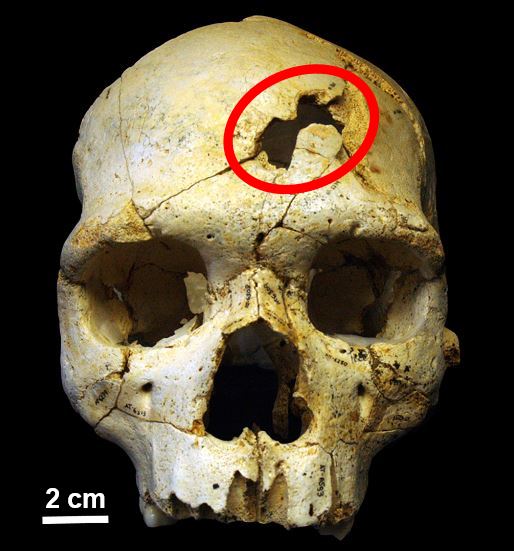Scientists have found evidence of what looks like a murder that occurred 430,000 years ago, after examining what appear to be lethal wounds on a human skull unearthed at the Spanish archaeological site of the Sima de los Huesos (‘Pit of Bones’).
A team of scientists from the US, Spain, France and China, who wrote about their findings in the research journal PLoS ONE, believe their study also offers evidence of the earliest funerary practices carried out by our ancient ancestors.
Sima de los Huesos is situated deep within an underground cave system, where so far the remains of more than 28 ancient humans who lived about 430,000 years ago (during the Middle Pleistocene period) have been found.
 The fractures on the skull (in the red circle) were probably caused by two blows from the same object, and not from a fall. (Image: PLoS ONE)
The fractures on the skull (in the red circle) were probably caused by two blows from the same object, and not from a fall. (Image: PLoS ONE)
The only way to get to the site is through a 13-metre deep vertical shaft. Scientists are unable to explain how the remains got there. They suggest people were dumped there after they died.
In this study the scientists focused on Cranium 17, which consists of fifty-two cranial fragments recovered during excavations at Sima de Los Huesos over a period of twenty years.
Two penetrating lesions were found on the skull, above the left eye.
Co-author, Rolf Quam, a paleoanthropologist at Binghamton University in New York, said:
“Evidence for interpersonal violence in the human fossil record is relatively scarce, and this would appear to represent the coldest cold case on record.”
Two blows from the same object
Using modern forensic techniques, including contour and trajectory analysis of the traumas, the team showed that the two fractures were probably produced by two separate impacts using the same object, with marginally different trajectories around the time of the individual’s death.
The scientists do not believe the injuries were caused by an accidental fall down the vertical shaft.
After examining the type of fractures, their location and that they were likely produced by two blows with the same object, the authors concluded that they were the result of a violent and fatal attack by one individual against another “or what may constitute the earliest case of murder in human history.”
Furthermore, if this person was already dead, others probably carried him or her to the top of the vertical shaft.
The authors believe that the accumulation of bodies in the Sima de los Huesos was the result of people bringing them there, which supports the idea that the site represents early evidence of funerary behaviour.
Prof. Quam said:
“This is really good evidence for an intentional role for humans in the accumulation of bodies at the bottom of this pit and suggests the hominins from this time period were already engaging in complex cognitive behaviors.”
In an interview with the BBC, Professor Debra Martin, an anthropologist from the University of Nevada specialising in signs of violence in ancient cultures, who described the scientists’ evidence and conclusions as ‘completely compelling’, said:
“I suspect the farther we push back and find straight up forensic evidence such as these authors have, we will find that violence is culturally mediated and has been with us as long as culture itself has been with us.”
Citation: “Lethal Interpersonal Violence in the Middle Pleistocene,” Nohemi Sala, José María Bermúdez de Castro, Eudald Carbonell, Juan Luis Arsuaga, Ana Pantoja-Pérez, Adrián Pablos, Ignacio Martínez, Rolf M. Quam & Asier Gómez-Olivencia. PLoS ONE. Published 27 May, 2015. DOI: 10.1371/journal.pone.0126589.
